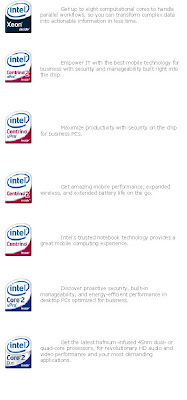Microsoft amassing high-performance server software Microsoft has built a strategy around the planned early-November release of its high-performance computing server that it hopes will be the catalyst to deliver massive computing power for future applications.
Sprint's WiMAX network set for October launchAfter months of anticipation, Sprint Nextel will make its WiMAX network available commercially for the first time in Baltimore next month.
NASA ramps up weather research with supercomputer clusterNASA's Center for Computational Sciences is nearly tripling the performance of a supercomputer it uses to simulate Earth's climate and weather, and our planet's relationship with the Sun.
No virtual bridge from Xeon to AMD, Intel saysVMware customers are getting a bit more freedom in the way they can transfer virtual machines from one Intel-based server to another, but they shouldn't hold their breath waiting for a bridge between Intel and AMD-based ...
Former Intel engineer charged with stealing trade secretsA former Intel Corp. design engineer has been charged with theft of trade secrets from the chipmaker while secretly working for rival Advanced Micro Devices, Inc.
Intel sees future with shape-shifting robots, wireless powerThe intelligence gap between man and machine will largely close by the year 2050, according to Intel's chief technology officer, who yesterday reiterated that point during a keynote address at the Intel Developer Forum.
Intel to release Nehalem laptop chips next yearConsumer laptops and desktops could get faster and more power-efficient when Intel releases chips built around its new Nehalem microarchitecture in the second half of 2009.
New York launches antitrust investigation of IntelNew York state Attorney General Andrew Cuomo has launched an antitrust investigation of Intel, and on Thursday, his office served a wide-ranging subpoena on the company.
How to buy a mini-laptopMini-laptops are among the hottest new products this year and with the back-to-school sales season upon us, I created a list of items to help you choose the right one.
Intel demos prototype in India of US$114 Atom deviceIntel Thursday showed a prototype of a range of low-cost "nettops' that are to be introduced in the country over the next several months. The devices, will be offered in the country by domestic and multinational PC ...
More cores, bigger cache give boost to DunningtonIntel plans to launch its six-core Xeon server processor next month, with the extra cores and a larger cache giving the chip a performance advantage over the company's existing quad-core chips.
Intel confirms OQO to use Atom in handheld PCIntel on Wednesday confirmed that its Atom chips will be used in an upcoming handheld computer from OQO, a significant design win for the chip maker.
Intel's next mobile chip prepped for samplingIntel on Wednesday said its next low-power chip for mobile phones is being readied for sampling -- progress for the chip maker that has big plans in the mobile space.
How You Can Reduce Your Power ConsumptionJoin me in talking Tom Simmons, Citrix Federal area Vice President, about why these companies joined forces to sponsor this event, learn how companies can participate, what would be considered a success and how you can ...
Intel laptop platform to boost graphics, power useIntel's next-generation platform for laptops will provide more visually stunning graphics and better power management features, the company said on Tuesday.
OQO shows off handheld computer based on AtomHandheld computer maker OQO showed off an Atom-based device at the Intel Developer Forum in San Francisco, a significant design win for the chip maker.
N-Data back with different patentsSix months after settling with the FTC on an Ethernet-related patent, Negotiated Data Solutions, or N-Data, is back in the headlines.
AMD aims high-end graphics cards at NvidiaAdvanced Micro Devices Tuesday unveiled a graphics card, the ATI Radeon HD 4870 X2, that is widely expected to outperform rival Nvidia's top-end graphics card, the GeForce GTX 280.
Intel plots a Web 2.0 play with FacebookIntel on Thursday said it would supply chips and programming tools to power Facebook servers, which Intel hopes will bring it a larger presence in the burgeoning Web 2.0 market.
LinuxWorld: Community roots bolster Linux growthLinux is beginning to find its legs as the foundation in many different technologies and in the process is fueling a feedback loop that is helping accelerate the operating system's popularity.
Intel to release anti-theft technology for laptopsIntel plans to release an anti-theft technology for laptops during the fourth quarter of this year, but the company isn't offering many details yet.
BULLETIN - New York launches antitrust investigation of IntelNew York state Attorney General Andrew Cuomo has launched an antitrust investigation of Intel, and on Thursday, his office served a wide-ranging subpoena on the company.
ia's Nano processor tops Intel's Atom in first reviewsPerformance comparisons of Via Technologies' Nano processor and Intel's Atom chip conducted by several hardware-enthusiast sites Tuesday confirmed what many industry observers have long suspected: the Taiwanese ...
Intel working on third generation of Classmate PCsIntel will announce details of the next generation of Classmate PCs soon, with new hardware and software that will make the laptops more user-friendly, the company said Wednesday.
Intel takes on embedded market with Atom chipTaking a jab at the embedded market, Intel on Wednesday said it was working on new x86 chips to use in devices ranging from consumer electronics to mobile phones.


